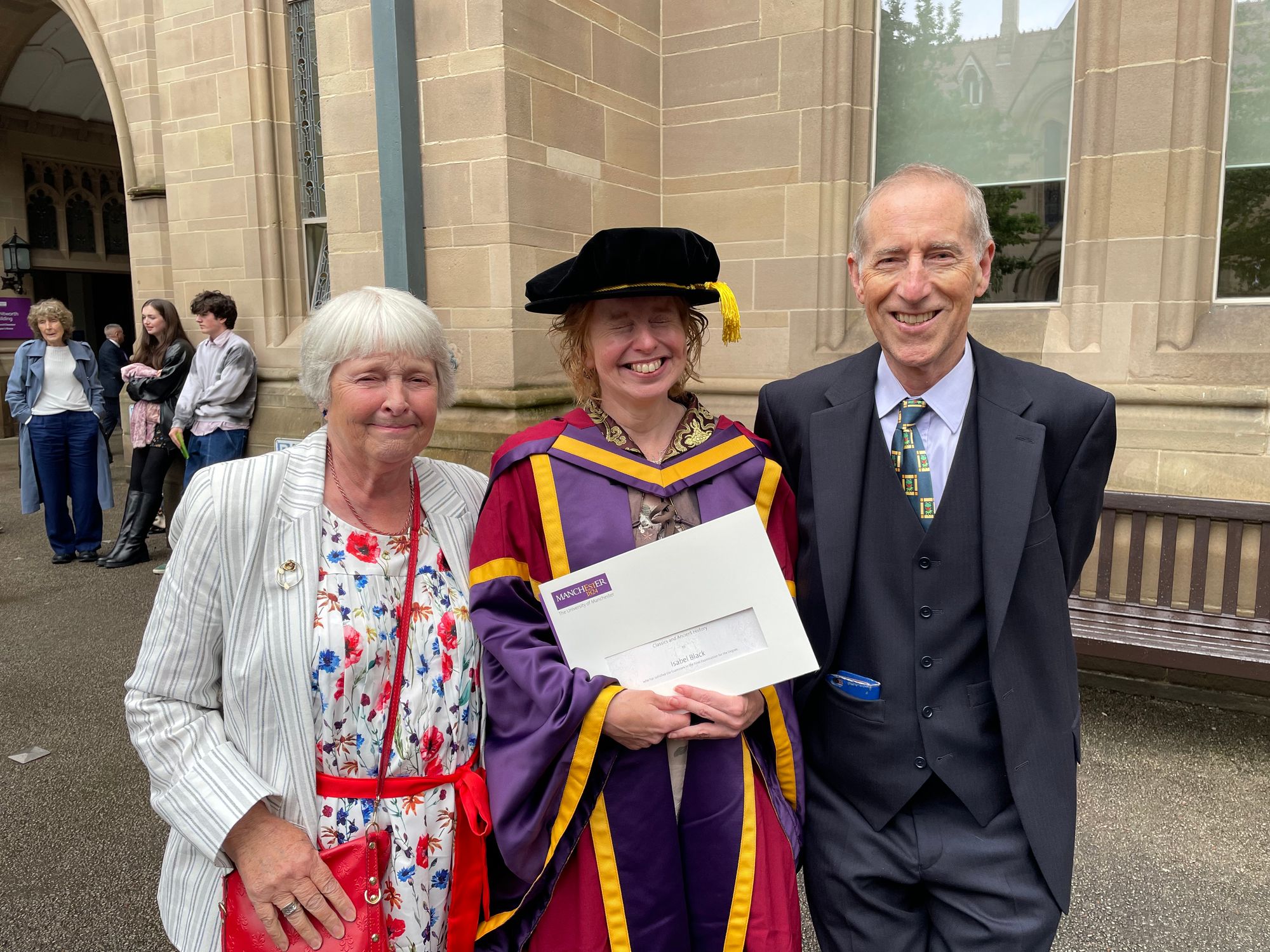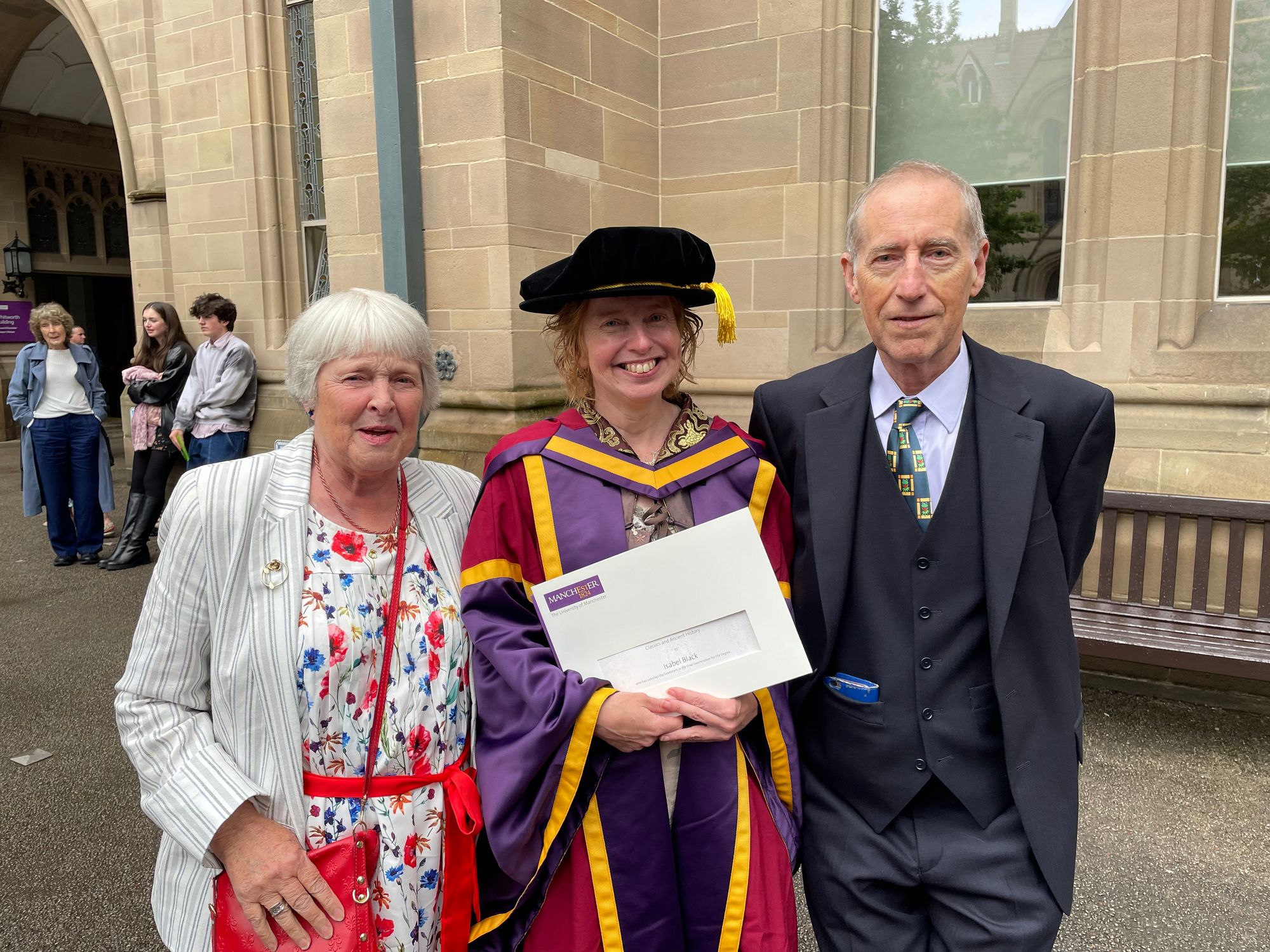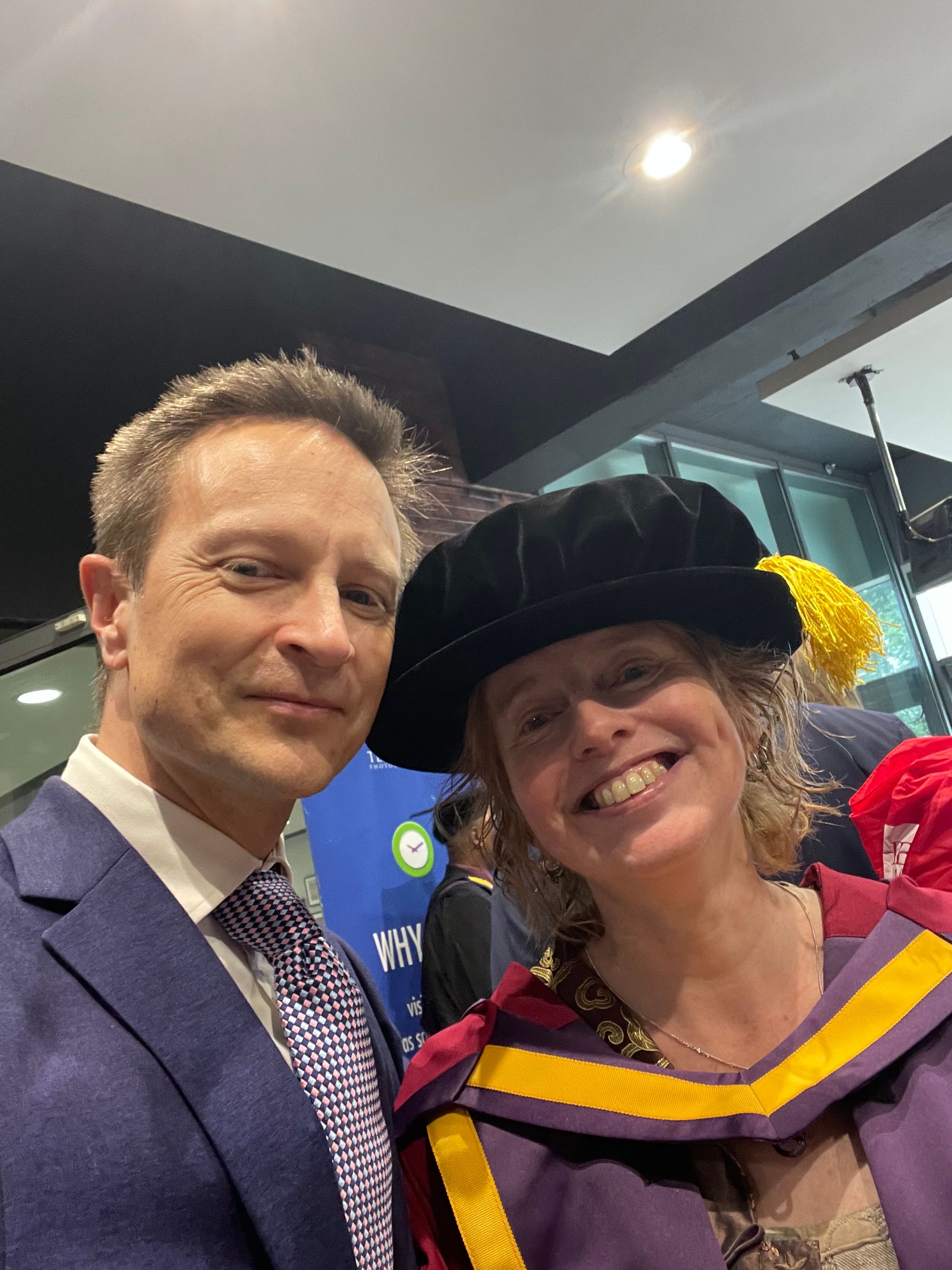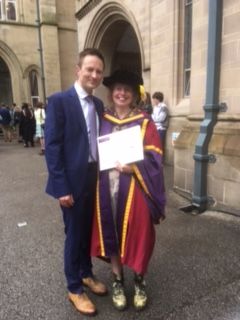Adventures with Necromantic Skulls: Materiality, Texts, and Objects
During the ritual stage, the practitioner divides themselves between drawing, speaking with the dead person, and then ensuring they can get what they want out of the dead person.

Introduction
Let me start by apologising that this post is a good two weeks late. I graduated (see photo for evidence), it was exhausting, and then I was sick.






OK, excuses dispensed with, I want to tell you a little bit more about necromantic skulls. My objective is to provide a little more background about the procedures mentioned by Klein and Zissu early last month in their review of the literature on the use of skulls in necromancy. I'd like to highlight a few similarities and differences between their find and the procedures* I've studied, and perhaps suggest a couple of reasons why that might have occurred.
The Cave of Skulls
As you might remember, a couple of weeks ago I mentioned this new paper by Klein and Zissu in my Friday object spotlight (when I did such a thing). A find of oil lamps, weaponry, and three human craniums were found in a cave outside Jerusalem, which the authors suggest may have been used for necromancy.
The date for the objects is around the first century A.D./C.E., and the authors felt that the skulls may have been used to seek oracles from the dead by pagans who moved into the area after Jewish communities were forced out.
They do mention, in their general review of the ancient literature on necromancy, that there are surviving procedures for making and activating necromantic skulls. They point, in fact, to two procedures I used during my own PhD: currently, they're known as PGM IV.2006–2125 and PGM IV.2125–39, although when the new edition of the fourth and fifth century magical formularies is published, this will change to GEMF (see Faraone and Torallas Tovar 2022).
Klein and Zissu only point to these procedures in very general terms as examples of how skulls may have been used, which of course gave me an opportunity to link to my own work and shed a little more light on the procedures, what they involved, and their basic materiality.
But First, The Codex
Before I get to the procedures themselves, we need to think about the materiality of the handbook itself. The two procedures in question come from a codex recently dated to the fourth–fifth centuries A.D., a solid three to four hundred years after the date of the cave find.
This is a first reason for being cautious about making any claims that the people using the skulls in the cave were using similar procedures in their work. We have a good span of time between the two sources, as well as a locational difference. The cave is outside Jerusalem, and PGM IV/GEMF 57 comes from Egypt (Faraone and Torallas Tovar forthcoming and 2022).
The third problem is one specific to the materiality of the codex. While earlier magical handbooks show thorough physical evidence of regular use, potentially in a ritual context (open on the table at the time, perhaps), in the form of notes, smudges, and general wear and tear, PGM IV does not have these same characteristics. One suggestion is that it may have been kept as an item of interest by a collector, but not necessarily put to practical use.
This makes it tricky to make a direct link between text and archaeological find.
The Absence of a Cave
The next problem is that neither of these two procedures mentions using a cave. It would be wonderful if they did, but they don't. PGM IV.2006–2125, entitled "Pitys' Spell of Attraction", describes how to prepare, activate, and use a dead body or skull as a necromantic oracle. Much of the action takes place either at home, or at what the Greek describes as somewhere something has been abandoned, discarded, or buried.
The procedure actually centres on the preparation of a set of inks and supports for drawn images to be used to summon and command the dead spirit. The dead of the Roman and Greek worlds, especially those who had died suddenly or by violence, were considered to exist in a state of limbo, and could be roped into working for practitioners in order to contact higher order supernatural agents to do their bidding or get what they wanted.
Instead of skulls and objects being deposited in a cave, we have a practitioner in Egypt preparing a piece of ass hide then inscribing images and magical words on it. This practitioner has to make three inks to create three separate drawings. Each drawing forms a particular stage of the procedure. During the ritual stage, the practitioner divides themselves between drawing, speaking with the dead person, and then ensuring they can get what they want out of the dead person.
The text of the first procedure ends by listing the ingredients for each type of ink. They are associated with the supernatural agent that has to be drawn in the image corresponding to that particular stage of the ritual. As it goes, the whole text is rich with material meaning, providing a lot of evidence for connections between supernatural forces and objects.
Differences and Similarities
As you can tell from Klein and Zissu's work, it's evident that there was a lot of cross-over and influence between cultures during this period. It's also clear that although the central idea of a skull being involved in a necromantic procedure, evidence from the range of sources they mention point to practitioners expounding on that central idea and taking it in new and interesting directions.
We have a lot of evidence from the textual sources, among them the Greek and Egyptian Magical Formularies, that these procedures frequently evolved, that they were adapted and changed over time and across linking cultures. Clifford Ando suggests that practices—magical and/or religious—during the period was experimental in nature; practitioners were effectively scientists interested in cause and effect. Therefore, if they performed a ritual and got the desired result, they knew to do that again. If it didn't, they had to adapt and change, trying something else.
The texts themselves often claim they are the "one true way", or "the best way" to get something done. The advertising text of PGM IV.2006–2125 makes some fairly bold claims that it's the best way to get a supernatural assistant. But these claims have the modern term "advertising text" for good reason. The texts also include statements for alternatives if materials are unavailable, or reference other magical handbooks where different approaches to sections of a procedure are mentioned.
Procedures also changed over time, across cultures, and between places. The foundational idea of the skull being the ideal means to connect back to the dead spirit remains, but the specifics of people, location, and time, change how that foundational idea appears (for more on this, see in particular Smith 1987).
Magic like this is fundamentally a creative, imaginative development. It's a way to cope with a difficult life, as Jacco Dieleman remarks, and people took what they saw around them and put it to use to these ends. A cave provides a liminal space, a link to the underworld in the same way that three-road crossroads and water also do (Dieleman 2012).
What Does It All Mean?
For a while, there was a desire in the scholarship on ancient magic to attempt to link archaeological discoveries and texts. The hunt was on for objects that exactly mirrored the texts describing their construction. This would prove, I suppose, that the procedures were real and that the texts were not artifices of the imagination.
Doing this has proved to be exceptionally difficult. The materials required for the procedures are often not durable and when they are, nothing looks quite as it's described. This led to lengthy debates about whether the Louvre doll came from the same a variation of the procedure PGM IV.296–466, for example.
Aside from materials not lasting the test of time, there is simply too much variation, and too little of the textual material has survived intact to enable us to draw those kind of one-to-one links. All we can do is attempt to interpret and understand—as sympathetically as possible—what we discover, when we find it.
Finally, I did mention a second procedure. It follows directly after the one describing how to set up and use your necromantic skull. This procedure, PGM IV.2125–39, describes what to do if that skull does not work correctly. This is a whole other problem, and illuminates something about magical practice in the ancient world I should perhaps save for a "Buy My Book!" moment.
The procedure is much shorter and more straightforward. I spent a lot of time studying it during my thesis, but what I will say here is that it points to the idea of magical failure not necessarily being a problem that is always the fault of the practitioner doing something incorrectly.
Personally, I love the idea that a magical object could fail, in the same way that a laptop runs slow or an iPhone has to be repaired. We have no idea, by the way, what the author of the procedure meant by their terms. They do not describe how the skull is failing. Is it not talking? Is it not doing as it's being told? Is it saying too much?
I think I'll save that one for another post, or maybe a whole journal article.
Notes
*I'm going to be calling these rituals "procedures" throughout, although for a long time they were referred to as either "rituals" or "spells" in the general scholarship. This is in line with Faraone and Torallas Tovar's (2022) reasoning about the nature of the documents, and creating a clear differentiation between instructions for making the tools of magical practice and specific rituals, which had to be performed.
Bibliography:
Dieleman, J. (2012). Coping with a Difficult Life: Magic, Healing, and Sacred Knowledge. In Riggs, C. (Ed.) The Oxford Handbook of Roman Egypt. (pp. 337-361). Oxford University Press. https://doi.org/10.1093/oxfordhb/9780199571451.013.0022
Faraone, C. A. (2002). The Ethnic Origin of a Roman-Era Philtokatadesmos. In Mirecki, P. and Meyer, M (Eds.) Magic and Ritual in the Ancient World. Brill.
Faraone, C. A. (2005). Necromancy Goes Underground: The Disguise of Skull- and Corpse-Divination in the Paris Magical Papyri (PGM IV.1928-2144). In Johnston, S. and Struck, P. (Eds.) Mantike: Studies in Ancient Divination (pp. 255–282). Brill.
Faraone, C. A., & Torallas Tovar, S. (Eds.). (2022). Greek and Egyptian magical formularies: Text and translation. California Classical Studies. (Volume I; Volume II forthcoming)
Klein, E., & Zissu, B. (2023). Oil Lamps, Spearheads and Skulls: Possible Evidence of Necromancy during Late Antiquity in the Te’omim Cave, Judean Hills. Harvard Theological Review, 116(3), 399-421. doi:10.1017/S0017816023000214
